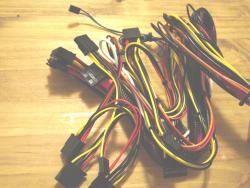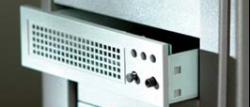2003 Power Supply Roundup Part II: Better Faster Cheaper
by Kristopher Kubicki on July 31, 2003 1:58 PM EST- Posted in
- Cases/Cooling/PSUs
We saw the elegant and simple TruePower a few months ago, so we were pretty excited to see if Antec had any other products in the PSU industry we could include in our roundup. The TrueControl 550 is Antec’s highest end product, allowing fan control through a designated 5.25” bay controller. Memories of our Sound Blaster LiveDrive instantly came to mind.
The controller itself is very utilitarian looking, but it seems to get the job done. For all Antec's worth, they probably could have made the controller look a little more appealing.
Antec clearly spared no expense on the 550W TrueControl, and we noticed this is a very different supply from the 430W TruePower we saw several months ago. Several interesting things caught our attention. First, this is the only power supply we have seen with an external rear molex connector. We are not really sure why, but there must be some applications for such a feature.
Also present were black molex connectors. Almost every power supply we have seen to date uses white or clear molexes. Besides the 7 standard molex connectors, the unit comes with 2 fan only connectors (also present on the TruePower 430W). The forward bay allows for control on the internal fans, as well as the fans along these designated fan control rails as well. A very interesting feature, but it is perhaps limited in usefulness. A motherboard fan control connector is also included.
Also, the TrueControl 550 comes with dedicated molexes for fan control. The 5.25" bay is capable of controlling these fans through the power supply. This is defiantly a nice touch since we have previously questioned whether the dedicated fan molexes were worthwhile.
Again, Antec makes the point of demonstrating that the TrueControl 550 has separate lines for each of its 3 main rails. The real element that separates this power supply from the ThermalTake PurePower is the variable voltage on the fan controller. Using the included tool, the unit allows you to modify your voltage settings to adjust within %5 each of the three main rails (+12V, +3.3V, +5V). While this is incredibly useful if you are a die hard overclocker, it can be very hazardous if used incorrectly. For example, underpowering your +12V rail might result in underpowering your P4 or video card, which will eventually damage your components if not careful.
Wattages
|
|
3.3V |
5V |
12V |
-12 |
-5 |
+5vsb |
combined theoretical |
actual combined |
advertised total |
|
Antec TrueControl 550 |
105.60 |
200.00 |
288.00 |
12.00 |
2.50 |
10.00 |
- |
- |
554.50 |
On paper, the theoretical combined 530W maximum impresses us. Remember, the unique feature about a lot of Antec power supplies is that they have separate rails for each of the three main power lines. The advertised +12V rail comes in very respectably at 288W. This power supply will work well for the hungriest of AMD or Intel systems. Die hard overclockers will enjoy the control over each rail, which is also offered on the PC Power and Cooling TurboCool. Be warned though, variable pot controls can seriously compromise your system's stability.
Unfortunately, this supply also weighs in as one of our most expensive units. This is somewhat against the grain of our last Antec power supply which was priced very moderately. For $130 you get the fan controller, and a lot of extras. The dedicated power rails are worth it for a serious overclocker, so albeit expensive, the TrueControl 550 still does not disappoint.












70 Comments
View All Comments
Anonymous User - Sunday, August 3, 2003 - link
While this review is better than most, I feel that the conclusions are flawed. Firstly, there is more to choosing a good PSU than mere performance figures alone, at time of testing, might suggest. Component quality was not taken into account, and is one reason why some PSUs cost more than others.Quality components lead to longer life, higher reliability, and less drifting of specifications over time.
A PSU that appears to be good value for money may not be so good when it fails and takes out your attached devices in the process.
Also, what happened to testing voltage stability under dynamic load conditions. You may find that some units that appeared to show good stability and low ripple under constant load conditions, will perform miserably under dynamic loads, which would be more like the conditions encountered in real usage senarios. Some poor designs may very well cause stability issues under such conditions, which were not apparent in the test results shown.
Good report, but the results are inconclusive.
Anonymous User - Sunday, August 3, 2003 - link
Could you post the settings or source modification to get memtest86 to delay the verify step of the testing?Anonymous User - Sunday, August 3, 2003 - link
Which one is better for a dual ahtlon mp, 64 bits raid 5 (4 disk) and hungry video card???Anonymous User - Sunday, August 3, 2003 - link
OK, I'm confused. Which rail is important to an AMD builder/overclocker? AMD's Power Supply PDF indicates that the mobo's switching power supply uses the 12V rail. My observation of several power supply specs and this article imply that the 3.3V rail actually supplies power to an AMD CPU. This article was clear about P4s using 12V rail. Which is it for AMD?? Or does it depend on the mobo manufacturer and how they decide to build their multi-phase switching regulator?Anonymous User - Sunday, August 3, 2003 - link
Hello,I would like to mention a few pitfalls with your article that are confusing to people I have talked to... Please accept this as constructive criticism as I do not intend to degrade the article in any way.
At first glance, I didn't know what you ment by "Theoretical Combined" in the specification table. I am assuming you did not read this off the power supply's label, but calculated it by adding the 3.3v and 5v lines. While this number (or variation of it) is usefull, I believe that "theoretical" is not the term you are looking for. This is definately NOT the theoretical power output of the combined 3.3/5v rail as the label on the PSU clearly states the theoretical peak power of the combined rail. There is circuitry in the PSU that determines what this theoretical peak power output is for the combined rail, and it has nothing to do with your calculated "theoretical combined" numbers given in the table.
I would encourage you to change the name of that column of your table, and modify the presentation of the number. I recommend giving a power delta from the MFG's specified peak power on the combined rail and your calculated combined rail and call it the "defficiency of combined". For instance: in the case of the Sparkle PSU, the MFG's spec says the combined rail can output a maximum of 220W. Your calculated combined power is 242.4W. I would recommend making the "defficiency of combined" colum state 22.4W. This would give people an idea that there is a 22.4W defficiency that must be spread over the 3.3V and 5V rails in real world usage. This would also reduce the confusion of the incorrect term of "combined theoretical".
The real meaning of "combined theoretical" is really what the MFG's specifications say. The real meaning of "actual combined" is really what you should have measured using something that slowly loads the PSU and then take the highest power output just before overload. I would also recommend that doing this slow power draw, let the PSU stand in that state for a few minutes before increasing power draw again (so increase the draw in steps, with a time interval in between each step) so you can get actual sustained power output.
For a more complete test of each individual rail, blow out 4 different PSU's by maxing out each individual rail, and then trying to max out the combined rail (without maxing out either of the 3.3/5v rails). I know this would be an expensive test, so I would recommend at least doing the latter test if only one PSU is available for testing.Some MFG's are including circuitry to detect overload and are shutting themselves down accordingly while others are just blowing themselves out upon overload. If you frowned upon blown out PSU's because of overloading in your review, it might give PSU MFG's incentive to include this circuitry in future revisions.
I commend you on your memtest86 results. This is a very good idea, and I'm sure it took up much of your time. Thank you for these results.
Caveman2001 - Saturday, August 2, 2003 - link
I posted a comment in the forum "articles" section, but since you removed it, I'll go ahead and repost.Post #15 and #18 have the right info regarding PCP&C silencer PSU's.
I have 2 SILENCER 400W PSU's by them and wouldn't trade it in for anything. As your tests prove, PCP&C make extremely high quality, ripple superior PSU's.
If you overclock, you'll never have to worry about your PSU being the problem if its from them. I hope you guys will get a 400W silencer so you can test and hear the difference.
Anonymous User - Saturday, August 2, 2003 - link
where can i get the modfied memtest86 så that i can try out the shielding test myself ?JPSJPS - Saturday, August 2, 2003 - link
Sorry about the double post! I have been getting timeouts recently here.Anonymous User - Saturday, August 2, 2003 - link
Kristopher - You obviously have spent a *LOT* of time and effort on this article but your technical knowledge is insufficient to produce meaningful valid results. You have made so many glaring technical mistakes/errors (it would take pages to correct them) that everything you presented is suspect.On a positive note, I volunteer to proof/edit/correct any future articles that you propose if you desire. You have my email.
I (JPSJPS) posted a short, minimal critique of your article here but only covered a few major points:
http://forums.anandtech.com/messageview.cfm?catid=...
Regards, JPSJPS
JPSJPS - Saturday, August 2, 2003 - link
KristopherYou obviously have spent a *LOT* of time and effort on this article but your technical knowledge is insufficient to produce meaningful valid results. You have made so many glaring technical mistakes/errors (it would take pages to correct them) that everything you presented is suspect.
On a positive note, I volunteer to proof/edit/correct any future articles that you propose if you desire. You have my email.
I posted a short, minimal critique of your article here but only covered a few major points:
http://forums.anandtech.com/messageview.cfm?catid=...
Regards, John